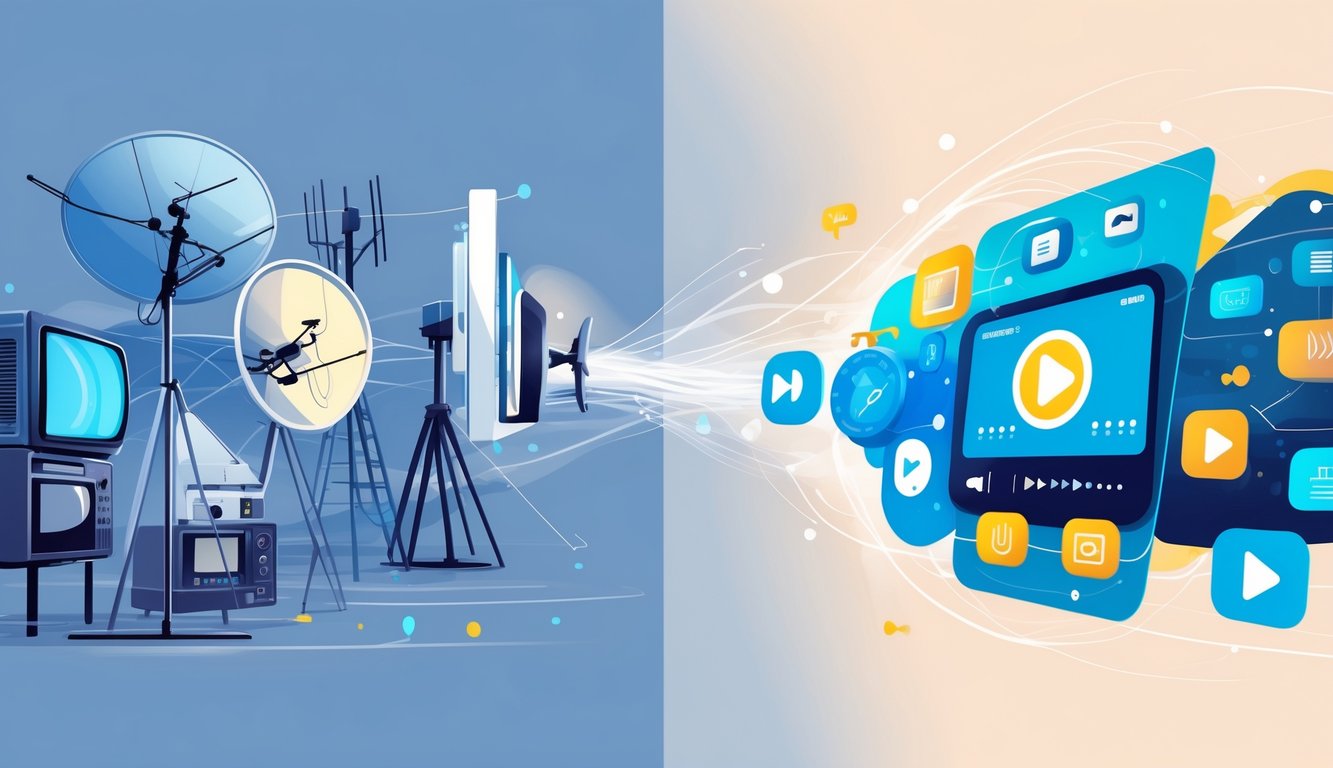
The Future Of Broadcast And Streaming Convergence
The numbers make my head hurt. Nielsen says streaming finally beat cable and broadcast combined: 44.8% share (not making this up). Schedules, platforms—they’re all melting together so fast I can’t keep track.
Hybrid Models And The Role Of Broadcast Media
Can someone remind me what TV was like before “FAST channels” took over? These Free Ad-supported Streaming TV things—PlutoTV, Roku Channel, Tubi—now make up more than 5% of TV viewing. Traditional execs look permanently confused, juggling new ad tech and local deals while clinging to whatever live events they can.
A TV insider I trust—who still blames everything on 2009’s digital switchover—insists broadcasters won’t ever give up sports, news, or “event TV” nights. But hybrid strategies are everywhere. Every network has its own OTT app now, just like Disney or NBCUniversal. The same sitcom or sports event appears on every platform, with “exclusive” features buried so deep nobody finds them. It’s cable déjà vu, just with fancier menus.
What’s Next For Content Creators And Audiences?
Isn’t it bizarre? Creators who used to stress over airtimes now lose sleep over thumbnails and algorithm hacks. My friend’s latest project? She’s pitching it to Hulu, a legacy network, and some FAST aggregator I’d never even heard of. Why not, if the rights contracts don’t trip you up? Chasing viewers is brutal, and writing “for broadcast only” is career suicide.
I’ve seen producers scramble to adapt—bite-sized cuts, bonus live chats, AI captions for TikTok, whatever works. The kicker: audience loyalty is basically a myth. A Fox Business report shows Netflix still rules, and YouTube’s user base doubled in four years. TV content isn’t dead, but calling it “television” feels wrong when it’s stitched together from streaming, broadcast, social, and—yes—DVDs still collecting dust at my aunt’s.
Frequently Asked Questions
Switching channels used to feel high-tech. Now, networks are spinning their wheels while the ground crumbles. Streaming hit fast-forward, and legacy broadcasters are scrambling to avoid looking like fossils to teens who won’t sit through a five-minute car ad.
What strategies are major networks using to compete with streaming services?
Honestly, old reruns and reality shows aren’t enough. Networks now stuff their platforms with exclusives, mini-series, and surprise live events. CBS threw cash at Paramount+ to catch Netflix leftovers, and NBCUniversal buried cable under Peacock’s on-demand Olympics and ad-supported tiers. When Paramount’s CEO Bob Bakish talks about “aggressive licensing,” he sounds as stressed as he looks.
I tried to untangle a subscription bundle once. It’s easier to buy a dishwasher than figure out who owns what.
How has the rise of streaming platforms affected traditional broadcast advertising revenues?
After years of staring at ad spend charts, I can’t ignore it: since 2020, broadcast ad money disappeared faster than my patience for insurance jingles. Advertisers bailed for Hulu and YouTube, where “engagement” means surveillance, not guesswork. When’s the last time you saw a primetime slot sell out? I haven’t, not since TikTok took over Sunday nights for anyone under 35.
Streaming platforms dodge most of the linear ad mess and can throttle ads with real-time data, a detail nobody talks about.
In what ways are broadcast networks integrating streaming into their business models?
Fox launched digital-only shows, NBC crammed reruns and sports into Peacock’s streaming bundles. Did anyone ask for another branded app? No. Some networks try “diginets”—extra digital channels piggybacked on the old spectrum. It’s like subletting your TV, but half those channels feel like late-night fever dreams.
Pro tip: I tried “TV everywhere” logins. Half the time, it only worked after I reset my cable password. Wish someone warned me.
What challenges do traditional broadcasters face in the transition to streaming-centric viewing?
Bandwidth costs explode with streaming—broadcast just sprays one signal, but streaming makes every device pull its own feed. I asked a network IT guy if this was sustainable. He laughed and called it an “unscalable nightmare.” Their infrastructure groans during big news, and digital ad fraud and churn rates? Don’t ask.
Executives keep slamming into tech costs and scalability headaches, and moving workflows to the cloud is apparently harder than getting people to stop pirating soccer games.
How are viewer habits changing with the shift from broadcast to streaming content?
So, last family gathering—nobody touched the TV remote, not even out of boredom. My cousin? She’s watching The Office reruns on her phone, right in the middle of dinner, like it’s totally normal. Is appointment TV even a thing anymore? Maybe for sports, I guess, or those weirdly tense presidential debates. But even then, you blink and Twitter’s already vomiting out every highlight before you can finish a sentence.
Honestly, I keep seeing these Nielsen stats—supposedly 18-34 year-olds are glued to Netflix and Disney+ way more than any of those ancient broadcasters. TV ratings keep tanking, streaming numbers climb every single year. I mean, does anyone under 20 even know what those spindly rabbit-ear antennas are for? I’d bet half of them think it’s some weird art project.
What new types of content are networks creating to capture the streaming audience?
Animated specials everywhere. Docuseries about some guy who maybe killed his neighbor’s dog or whatever—honestly, I can’t keep up. Then there’s this flood of short, supposedly “funny” comedies that seem like they were written by someone who’s watched too much TikTok but never actually laughed. I saw ABC throw out this interactive reality show app where, no joke, you’re supposed to vote in real time. It’s like, are we in an episode of Black Mirror now? Am I supposed to be impressed or just mildly concerned?
Unscripted junk, bingeable scripted stuff, more of it every week. And these media giants—what are they even doing? Bundling five streaming services together, digging up licensing deals from the grave, and then oh, let’s add “fast channels,” which is just regular TV but now you need a login and, I guess, more ads? Not sure who asked for that. Honestly, most of these “exclusive drops” look like reruns with fancier thumbnails. My TV remote wants a password now. Progress? Maybe. Or maybe I just need a nap.



